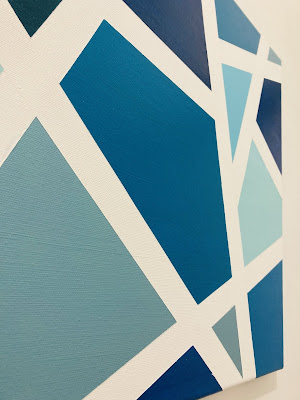Canvas masking tape art
Painting using masking tape is fun. It’s simple, yet can give a sophisticated abstract result. The colour palette is key!
Colours
So, before delving into the how-to, let’s talk colours. I remember trying this project as a child with very different, psychedelic outcomes! For an understated and tasteful piece which would fit right in in your grown-up living room, I’d recommend sticking to one main colour in 4-5 different tones.
For example, in this piece my main colour was blue. I used two blue paints, Cerulean Blue and Ultramarine Blue. I mixed each of them with some green or made them lighter/darker by adding white/black. Then, for additional shades I muted some of them down.
How to mute colours
You can mute, or unsaturate, any colour by simply mixing it with its complementary colour. And what is a complementary colour, you ask? For that you’ll need a colour wheel! Each colour’s complementary colour is the one opposite it.
 |
| Colour wheel - Remember these from art class? Photo: Printablee |
Complementary colours
Blue - Orange
Green - Red
Yellow - Purple
 |
| Photo: Tech Patio |
So, for a muted blue, mix in a little bit of orange until you get the desired shade.
Muted colours are an elegant partner to their vibrant equivalent, so don’t be afraid to include both muted and bright colours in your piece.
And now...What you will need for the masking tape artwork
- Canvas
- Masking tape
- Large paintbrush
- Acrylic paints
- Containers to mix them in (preferably with a lid or ones you can cling film over to use again for second and third coats)
- Sketch your design on a small piece of paper.
- On the canvas, mask the area you’d like covered. Ensure it is pressed down really well so none of the paint bleeds under it.
- Mix your colours in containers and test them on a rough piece of paper. Ensure you mix plenty of paint from the start to have enough for second and third coats later.
- Paint away!
- Let dry. Cover your paint containers in the meantime.
- Repeat painting until you’re happy.
- Peel off masking tape.
- If any paint has leaked under your masking tape, use the tape you’ve peeled off to cover the painted area next to it and paint over that leaked paint in white. I opted to paint over all the masked area in white at the end for a uniform feel, but that’s optional.
- Hang up and enjoy!


